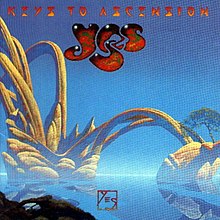
Yes are an English progressive rock band formed in London in 1968 by lead singer Jon Anderson, bassist Chris Squire, guitarist Peter Banks, keyboardist Tony Kaye, and drummer Bill Bruford. The band has undergone numerous lineup changes throughout their history, during which 20 musicians have been full-time members. Since February 2023, the band has consisted of guitarist Steve Howe, keyboardist Geoff Downes, bassist Billy Sherwood, singer Jon Davison, and drummer Jay Schellen. Yes have explored several musical styles over the years and are most notably regarded as progressive rock pioneers.

Jon Roy Anderson is an English-American singer, songwriter and musician, best known as the former lead singer of the progressive rock band Yes, which he formed in 1968 with bassist Chris Squire. He was a member of the band across three tenures until 2008. Anderson was also a member of ARW along with former Yes bandmates Rick Wakeman and Trevor Rabin from 2016 to 2020. Together with bassist Lee Pomeroy and drummer Lou Molino III, they toured under the name Yes Featuring Jon Anderson, Trevor Rabin, Rick Wakeman.
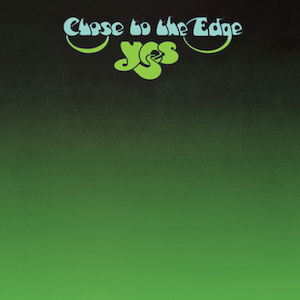
Close to the Edge is the fifth studio album by English progressive rock band Yes. It was released on 8 September 1972 by Atlantic Records, and is their last album of the 1970s to feature their original drummer Bill Bruford. After scoring a commercial and critical hit with Fragile and touring the album, Yes regrouped to prepare material for a follow-up, ideas for which had been put down some months before. The album's centrepiece is the 18-minute title track, with themes and lyrics inspired by the Herman Hesse novel Siddhartha. Side two contains two non-conceptual tracks, the folk-inspired "And You and I" and the comparatively straightforward rocker "Siberian Khatru". Bruford found the album particularly laborious to make, which culminated in his decision to quit the band after it was recorded, to join King Crimson.

Tales from Topographic Oceans is the sixth studio album by English progressive rock band Yes, released on 7 December 1973 by Atlantic Records. It is their first studio album to feature drummer Alan White, who had replaced Bill Bruford the previous year. Frontman Jon Anderson devised its concept during the Close to the Edge Tour, when he read a footnote in Autobiography of a Yogi by Paramahansa Yogananda that describes four bodies of Hindu texts about a specific field of knowledge, collectively named shastras–śruti, smriti, puranas, and tantras. After pitching the idea to guitarist Steve Howe, the pair spent the rest of the tour developing an outline of the album's musical themes and lyrics.
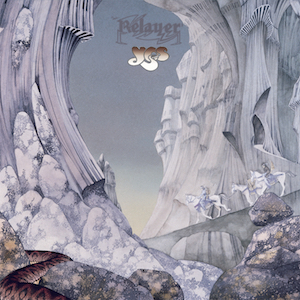
Relayer is the seventh studio album by the English progressive rock band Yes, released in November 1974 by Atlantic Records. After keyboardist Rick Wakeman left the group in May 1974 over disagreements with the band's direction following their double concept album Tales from Topographic Oceans (1973), Yes entered rehearsals as a four-piece in Buckinghamshire. They auditioned several musicians, including Greek keyboardist and composer Vangelis, before settling with Swiss musician Patrick Moraz of Refugee who incorporated elements of funk and jazz fusion to the album. Relayer is formed of three tracks, with "The Gates of Delirium" on side one and "Sound Chaser" and "To Be Over" on side two.

Union is the thirteenth studio album by English progressive rock band Yes, released on 30 April 1991 by Arista Records. Production began following the amalgamation of two bands that featured previous and then-current members of Yes: Anderson Bruford Wakeman Howe (ABWH), consisting of vocalist Jon Anderson, drummer Bill Bruford, keyboardist Rick Wakeman and guitarist Steve Howe, and Yes, comprised at that time of bassist and vocalist Chris Squire, guitarist and vocalist Trevor Rabin, keyboardist Tony Kaye and drummer Alan White. The eight musicians signed with Arista and a combination of unfinished tracks by both groups were selected for Union. The album's sessions were problematic from the start, including disagreements between some of the musicians regarding the "merger" of the two bands, strained relations during the recording process, and decisions by the production team of Anderson and producer Jonathan Elias to bring in session musicians to re-record parts that Wakeman and Howe had originally completed.
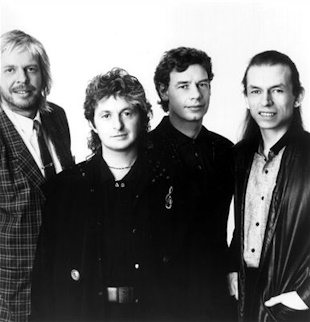
Anderson Bruford Wakeman Howe (ABWH) were an English progressive rock band active from 1988 to 1990 that comprised four past members of the English progressive rock band Yes. Singer Jon Anderson left Yes as he felt increasingly constrained by their commercial and pop-oriented direction in the 1980s. He began an album with other members from the band's 1970s era: guitarist Steve Howe, keyboardist Rick Wakeman, and drummer Bill Bruford, plus bassist Tony Levin.

Anderson Bruford Wakeman Howe is the only studio album by English progressive rock band Anderson Bruford Wakeman Howe, released in June 1989 on Arista Records.

Keys to Ascension 2 is the fifth live and sixteenth studio album by the English progressive rock band Yes. It was released as a double album in November 1997 by Essential Records as the successor to the previous live/studio album Keys to Ascension. After guitarist Steve Howe and keyboardist Rick Wakeman returned to the band in 1995, the group relocated to San Luis Obispo, California and started to write new material. The reunion of this particular line-up was promoted with three concerts at the city's Fremont Theater in March 1996, the five's first live performance together since 1979. Keys to Ascension 2 features the remaining half of the live set from the 1996 shows and five new studio tracks including two ones which marked a return to the group writing long-form pieces.

Tormato is the ninth studio album by English progressive rock band Yes. It was released on 22 September 1978 on Atlantic Records, and is their last album with singer Jon Anderson and keyboardist Rick Wakeman before their departure from the group in 1980. After touring their previous album Going for the One (1977), the band entered rehearsals in London to record a follow-up. The album was affected by various problems, such as internal disputes over the direction of the music and artwork, and the departure of engineer Eddy Offord early into the sessions, resulting in the group producing the album themselves.

Big Generator is the twelfth studio album by English progressive rock band Yes, released on 21 September 1987 by Atco Records. After touring in support of their previous album, 90125 (1983), which saw the band move from progressive rock towards a pop-oriented and commercially accessible direction, Yes started work on a follow-up in 1985 with producer Trevor Horn. It was a laborious album to make; recording began at Carimate, Italy, but internal and creative differences resulted in production to resume in London, where Horn ended his time with the band due to continuing problems. The album was completed in Los Angeles in 1987 by Trevor Rabin and producer Paul DeVilliers.

Yesshows is the second live album by the English progressive rock band Yes. It was released in November 1980 on Atlantic Records as the final album before the group disbanded in early 1981. Their first live album in seven years, it is compiled of recordings from their 1976, 1977, and 1978 tours from dates in North America and Europe with its mixing supervised by bassist Chris Squire.

Magnification is the nineteenth studio album by the English progressive rock band Yes, released on 10 September 2001 by Eagle Records. It is their only album recorded as a four-piece band, and their final album to feature founding member Jon Anderson on vocals. At the departure of keyboardist Igor Khoroshev in 2000, the band agreed to record a new studio album with orchestral arrangements, something they had not done since their second album, Time and a Word in 1970. The album was recorded and mixed using Pro Tools with producer Tim Weidner and orchestral arrangements by Larry Groupé conducting the San Diego Symphony Orchestra. Drummer Alan White plays piano on some tracks.

Talk is the fourteenth studio album by the English progressive rock band Yes. It was released on 21 March 1994 by Victory Music, and is their last studio album to feature guitarist Trevor Rabin and keyboardist Tony Kaye.
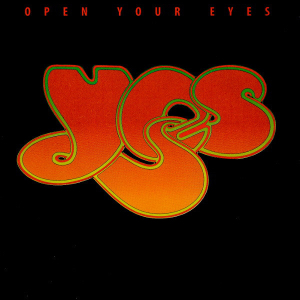
Open Your Eyes is the seventeenth studio album by the English rock band Yes, released in November 1997 by Eagle Records in the UK and by Beyond Music in the US. Following the 1996 revival of the 1970s "classic" line-up of Yes, the band's relationship with management had broken down and keyboardist Rick Wakeman had once again left the band. While various other members dispersed, guitarist, keyboardist, and producer Billy Sherwood began developing new songs with band bassist and de facto leader Chris Squire to prevent the band from losing momentum and fully splitting. Yes' new management company suggested adding a couple of songs originally written for Squire and Sherwood's other band Conspiracy to help build up material for a new Yes studio album. With the writing and production sessions dominated by Squire and Sherwood, and with singer Jon Anderson, guitarist Steve Howe and drummer Alan White only involved later in the process, the writing and creative input of the latter three members was limited.
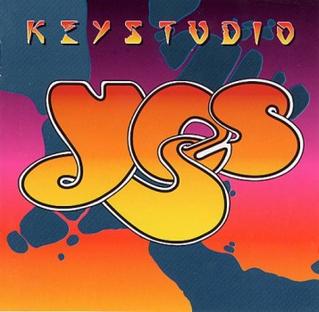
Keystudio is a compilation album by the English progressive rock band Yes, released in May 2001 by Castle Music in the United Kingdom and by Sanctuary Records in the United States. It is formed of the studio tracks previously released on live/studio albums Keys to Ascension (1996) and Keys to Ascension 2 (1997).

Keys to Ascension is a video album by English progressive rock band Yes, released in October 1996 by CMC International. It featured the group's performances at the Fremont Theatre in San Luis Obispo, California in March 1996, following the return of guitarist Steve Howe and keyboardist Rick Wakeman in 1995, which marked the first performances of the band's "classic" line-up since 1979. The three concerts with the newly reunited lineup were followed by two double albums entitled Keys to Ascension and Keys to Ascension 2, featuring all new material alongside live tracks from the San Luis Obispo shows. This along with these companion albums were reissued in 2010 as the Keys to Ascension box set.

Yes Featuring Jon Anderson, Trevor Rabin, Rick Wakeman, also known as Anderson, Rabin and Wakeman (ARW), were a progressive rock band founded by former Yes members Jon Anderson, Trevor Rabin, and Rick Wakeman (keyboards) in an offshoot of the band. The three had previously worked together in Yes for the 1991–1992 Union Tour. The trio were first announced as working together in 2010.
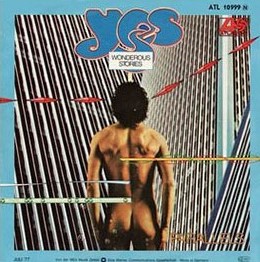
"Wonderous Stories" is a song by the English progressive rock band Yes, released in September 1977 as the first single from their eighth studio album, Going for the One. It was written by lead vocalist Jon Anderson, who gained inspiration for the song one morning during his stay in Montreux, Switzerland where the band recorded the album. The song reached number 7 on the UK Singles Chart and remains the band's highest-charting single in the country.
